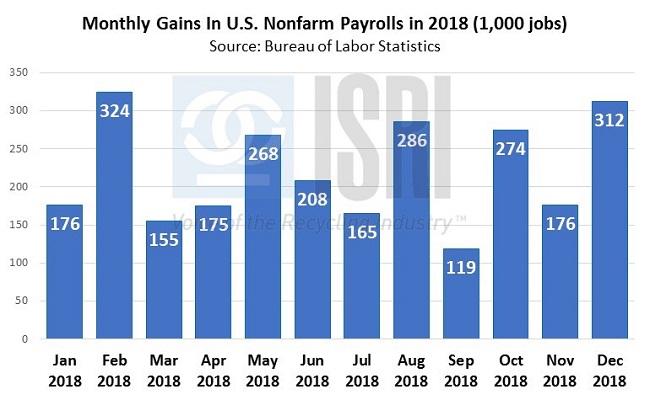On Friday, the Bureau of Labor Statistics reported U.S. nonfarm payrolls rose by 312,000 in December, easily beating expectations and continuing the expansion in U.S. jobs that began in October 2010.

Manufacturers continue to hire more employees, contributing to the nation’s job growth. According to the BLS: “Manufacturing added 32,000 jobs in December. Most of the gain occurred in the durable goods
component (+19,000), with job growth in fabricated metal products (+7,000) and in computer and electronic products (+4,000). Employment in the nondurable goods component also increased over the month (+13,000). Manufacturing employment increased by 284,000 over the year, with about three-fourths of the gain in durable goods industries. Manufacturing had added 207,000 jobs in 2017.”
However, leading indicators on manufacturing have become somewhat less encouraging as of late. According to the Institute for Supply Management, the U.S. manufacturing PMI declined from 59.3 in November to 54.1 in December as new orders dropped from 62.1 in November to 51.1 last month. The drop in U.S. manufacturing PMI came on top of disappointing Chinese PMI numbers earlier in the week.

Here’s what some of the ISM survey respondents had to say:
- “Growth appears to have stopped. Resources still focused on re-sourcing for U.S. tariff mitigation out of China.” (Computer & Electronic Products)
- “Brexit has become a problem due to labeling changes.” (Chemical Products)
- “Customer demand continues to decrease [due to] concerns about the economy and tariffs.” (Transportation Equipment)
- “Starting to see more and more inflationary increases for raw materials. Also, suppliers [are] forcing price increases due to tariffs.” (Food, Beverage & Tobacco Products)
- “The ongoing open issues with tariffs between U.S. and China are causing longer-term concerns about costs and sourcing strategies for our manufacturing operations. We were anticipating more clarity [regarding] tariffs at the end of 2018.” (Machinery)
- “Business is steady, but pace of incoming orders are slowing.” (Furniture & Related Products)
- “Business is robust for certain sectors [aerospace] and flat to downward for others [energy]. Tariffs continue to impact business direction and profit.” (Miscellaneous Manufacturing)
- “Caution seems to be the outlook. Are we in a correction, or is the market getting ready to slow over time?” (Fabricated Metal Products)
- “No major change in business operations towards the end of 2018; however, we are carefully monitoring oil prices and outside influence from market conditions to better understand our 2019 outlook and capital plans.” (Petroleum & Coal Products)
- “Customers are hedge buying in December as a result of announced price increases starting in January.” (Textile Mills)
Back to Main